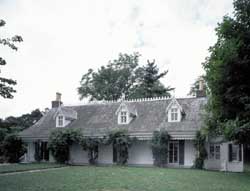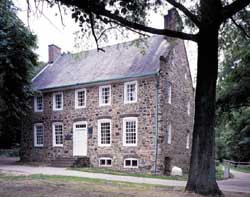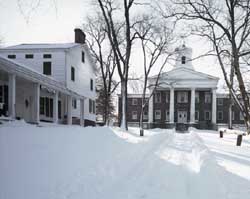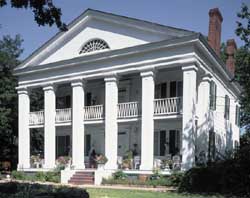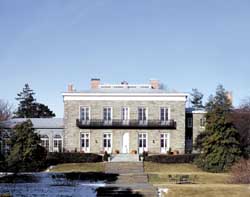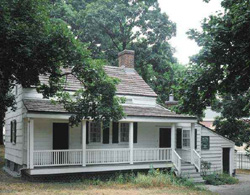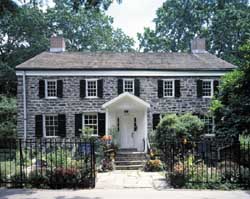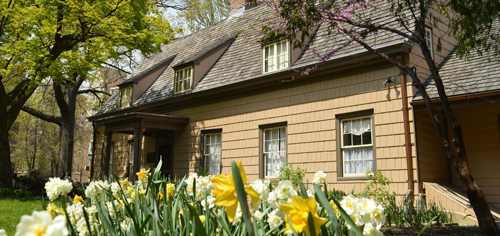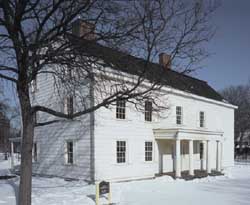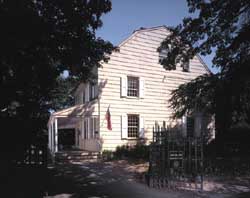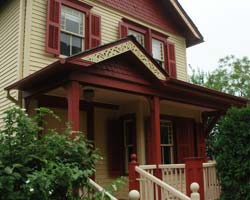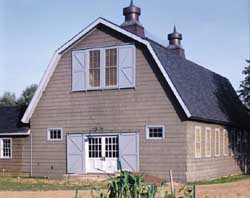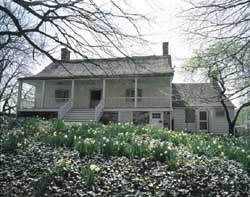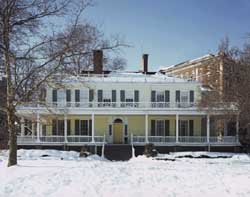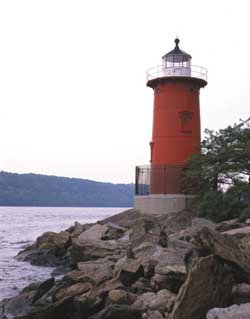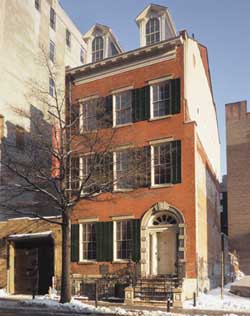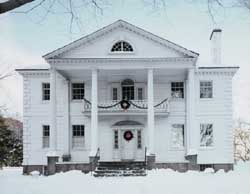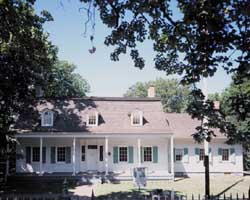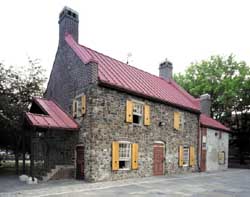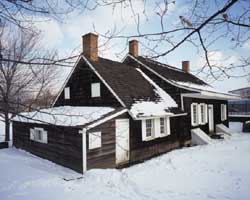Historic Houses
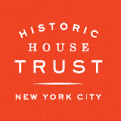
Our unique historic houses provide living examples of the past. They transport us to another time and help us to appreciate the history of the City of New York. To assure that these resources are preserved for future generations, the Historic House Trust (HHT) needs the public's support and patronage.
For information about donations to the Trust or to obtain general information, please visit the Historic House Trust website, call (212) 360-8282, or write to the Historic House Trust of New York City at 830 Fifth Avenue, The Arsenal, Room 203, Central Park, New York, NY 10065.
Visit our Historic House events page for a listing of upcoming fundraisers and events.
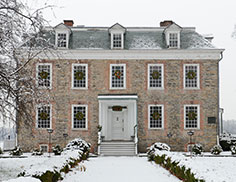
Search for Historic Houses Near You
Locations
Alice Austen House Museum
2 Hylan Boulevard
 limited
limitedPhone: (718) 816-4506
Description: The Alice Austen House Museum on Staten Island recalls the world of an exceptional woman, photographer Alice Austen. Her photographs represent street and private life through the lens of a lesbian woman whose life spanned from 1866 to 1952. Austen's quaint, Victorian cottage-style home, with a magnificent view of New York Harbor, displays prints from the large glass negative collection of her work that depicts turn-of-the-century American life. The original house, one of the City's oldest, dates back to the 1690s. The property was bought in 1844 by John H. Austen, Alice's grandfather. Austen expanded the small, one-and-a-half-story farmhouse, and named it "Clear Comfort". Alice Austen was born nearby in 1866. After her father abandoned the family, she and her mother moved into her grandparents' home and Alice continued to live in the house until 1945. Austen would spend 53 years in a devoted loving relationship with Gertrude Tate. They spent 30 years living together in this home, which is now the site of the Alice Austen House Museum and a nationally-designated site of LGBTQ history. Austen went on to become one of the most influential photographers of the 20th Century. The City bought the Austen house in 1975, and today the Friends of Alice Austen House operates the museum.
Alice Austen House Museum Links
Conference House
7455 Hylan Boulevard
 limited
limitedPhone: (718) 984-6046
Description: At the southernmost tip of Staten Island—and New York State—stands the Conference House, a 17th-century stone manor. In 1676, British naval captain Christopher Billop was granted a 932-acre property known as the Manor of Bentley. Billop built the Conference House, a solid, two-story structure of native fieldstone, in about 1680. During the American Revolution, the owner of the manor was Captain Billop's great-grandson, a Tory colonel also called Christopher Billop. On September 11, 1776, his house was the site of peace negotiations between British Lord Admiral Richard Howe and Benjamin Franklin, John Adams, and Edward Rutledge. The talks were unsuccessful, and the war continued for seven more years. After the Revolution, the house was confiscated by the State of New York; it served as a multi-family dwelling, a 19th-century hotel, and as a rat-poison factory before being deeded to the City of New York in 1926. In 1929, the Conference House Association took over operation of the house and has taken care of it since that time.
Conference House Links
Historic Richmond Town
441 Clarke Avenue
 limited
limitedPhone: (718) 351-1611
Description: Historic Richmond Town, in the heart of Staten Island, is a remarkable living history village and museum complex that encompasses three hundred years of the history and culture of New York City. The Town of Richmond, which began as a modest hamlet in the 1690s, became Staten Island's county seat of government in 1728. After Staten Island was incorporated into the City of New York in 1898, its government offices were moved to the town of St. George, and Richmond gradually became a quiet residential area. In 1935, the Staten Island Historical Society first opened New York City's only historic village. The Society acquired the 1848 County Clerk's office and established the Historical Museum. In 1939, the Society acquired and restored the Voorlezer's House (circa 1695), the nation's oldest building that served as a schoolhouse. Today, Richmond Town's 100 acres include 28 historic buildings dating from the late 17th to the early 20th centuries, half of which stand on their original locations. Historic Richmond Town is a joint project of the Staten Island Historical Society, a not-for-profit cultural organization, and the City of New York, which owns the park land and buildings and supports part of its operations with public funds provided through the Department of Cultural Affairs.
Historic Richmond Town Links
Seguine Mansion
440 Seguine Avenue
Description: Along the southern shore of Staten Island, the Seguine Mansion, a stately Greek Revival structure, faces Prince's Bay. Built in 1838 by Joseph H. Seguine, the house is a physical reminder of the classical architecture and thriving commerce of Staten Island during the mid-19th century. Sometime between 1780 and 1786, James Seguine bought a large parcel of land near Lemon Creek from Abraham Manee, whose French Huguenot family had held the land since about 1700. Joseph, James Seguine's grandson, and the fifth generation of the family on Staten Island, built the elegant two-and-a-half-story house, typical of high-style homes in the region at that time. Following Joseph's death in 1856, the house remained in the family until 1868. When it was sold, the amount of land had decreased to 10 acres. During the late 19th century, the building served as an inn or hotel, at a time when Prince's Bay had become a popular resort area. The house returned to Seguine descendants from 1916 through 1977 and was then sold at auction in 1981 to George Burke. Burke stabilized the deteriorated house in 1989 and donated it to the City of New York, while retaining a life interest.
Seguine Mansion Links
Bartow-Pell Mansion Museum
895 Shore Road
Phone: (718) 885-1461
Description: Nestled deep in the woods of Pelham Bay Park and only a mile from a network of bustling highways in the Bronx, the Bartow-Pell Mansion Museum is a rare example of country elegance in New York City. The Greek Revival house, originally occupied by publisher Robert Bartow and family in 1842, sits on an estate that dates back to 1654 when Thomas Pell, an English doctor from Connecticut, bought the land from the Siwanoy Indians. The property was acquired by the City in 1888, and the mansion was used by Mayor Fiorello LaGuardia as a summer office in 1936. It opened as a museum in 1946.
Bartow-Pell Mansion Museum Links
Edgar Allan Poe Cottage
East Kingsbridge Road and Grand Concourse
 in construction, will be accessible
in construction, will be accessiblePhone: (718) 881-8900
Description: The tiny Poe cottage in the Bronx, built by John Wheeler in 1812, was the last home of Edgar Allan Poe (1809-1849), the great American poet and author. Set in a small park on the Grand Concourse, it is the only house left from the old village of Fordham. Poe leased the one-and-a-half-story cottage for $100 a year and wrote many of his classic works there including "The Bells," "Eureka" and "Annabel Lee." The cottage, saved from destruction in the 1890s by the Shakespeare Society and moved from its original location on the other side of Kingsbridge Road in 1913, preserves a precious chapter of New York's literary heritage.
Edgar Allan Poe Cottage Links
Valentine-Varian House
3266 Bainbridge Avenue at East 208th Street
Phone: (718) 881-8900
Description: The second oldest house in the Bronx, the Valentine-Varian House was built by blacksmith and farmer Isaac Valentine in 1758, a time when carriages traveled the nearby Boston Post Road through a Bronx that was still mostly farmland. During the Revolutionary War, Valentine and his family had to abandon their two-story fieldstone home, which was occupied by British, Hessian, and American troops. Though close to several fierce battles with cannons clustered on a nearby hill, the house miraculously survived. In 1965, the house was donated to The Bronx County Historical Society, moved diagonally across the street to its present location on a new foundation, and now operates as the Museum of Bronx History.
Valentine-Varian House Links
Van Cortlandt House Museum
Broadway at West 246th Street
Phone: (718) 543-3344
Description: As New York City’s first historic house museum, Van Cortlandt House contains an outstanding collection of furniture and decorative arts, including many heirlooms donated back to the house by members of the Van Cortlandt family. In 1694, Jacobus Van Cortlandt, a merchant and Mayor of New York (1710-11, 1719-20), purchased the parcel of land that today contains Van Cortlandt Park and the Van Cortlandt House Museum. His son Frederick built the current house, the oldest in the Bronx, in 1748-49. George Washington stayed at the Van Cortlandt House at least twice during the Revolutionary War. Van Cortlandt descendants lived in the House until 1886, when they sold the entire estate to the City of New York for Van Cortlandt Park. In 1896, The National Society of Colonial Dames in the State of New York restored the House as a museum and operates it to this day.
Van Cortlandt House Museum Links
Bowne House
37-01 Bowne Street
Description: Built circa 1661, the Bowne House is a microcosm of social, cultural, and political history. It is one of the oldest surviving structures in New York City and the oldest in Queens. The Bowne House is a fine example of mid-17th-century Anglo-Dutch architecture with an exceptional collection of furnishings, but its true magic is its story. The house was built by John Bowne, a prominent Quaker and advocate of religious freedom, who emigrated from England to Boston in 1649 and eventually settled in Flushing, Queens. The contributions of this family to New York City’s heritage began with the courageous actions of John Bowne (1627-1695), who used the house as the first indoor meeting place for the Society of Friends, at a time when religious diversity was forbidden by law. The house and grounds are currently closed for restoration.
Bowne House Links
King Manor Museum
150-03 Jamaica Avenue

Phone: (718) 206-0545
Description: King Manor is the centerpiece of an 11-acre historic park in Jamaica, Queens. The 18th- and 19th-century house takes its name from Rufus King, a signer of the United States Constitution. In 1805, Rufus King bought an existing farm that included an 18th-century Dutch-style house with an attached Long Island-style "half house." A year after moving in, King added a kitchen to the rear of the Dutch house. He further expanded the structure four years later to its stylish Georgian grandeur by adding a Federal dining room and two bedrooms. After King's death in 1827, his son John lived in the house and added the Greek Revival exterior details, such as the classical portico and entranceway. The house was purchased by the Village of Jamaica in 1896, and two years later, it was transferred to the City. King Manor Museum reopened to the public in 1994.
King Manor Museum Links
Kingsland Homestead
143-35 37th Avenue

Phone: (718) 939-0647
Description: Kingsland Homestead, a late 18th-century house in Flushing, stands in the shade of the Weeping Beech tree, a designated City landmark, planted in 1847. Located steps away from the 17th-century Bowne House, where Quakers were first permitted to meet in New Amsterdam, Kingsland is the headquarters of the Queens Historical Society. Charles Doughty built Kingsland around 1785, and in 1801, ownership passed to his son-in-law, British sea captain Joseph King, giving the property its name. In 1968, the three-year-old Kingsland Preservation Committee had the homestead and, threatened by area construction, transferred it to its present location.
Kingsland Homestead Links
Lewis H. Latimer House
34-41 137th Street

Phone: (718) 961-8585
Description: The Lewis H. Latimer House is a modest Queen Anne-style, wood-frame suburban residence constructed in Flushing, Queens between 1887 and 1889 by the Sexton family. Lewis Howard Latimer, an African-American inventor and electrical pioneer and the son of fugitive slaves, lived in the house from 1903 until his death in 1928. During his career, he worked with three of the greatest scientific inventors in American history, including Alexander Graham Bell, Hiram S. Maxim, and Thomas Alva Edison. He played a critical role in the development of the telephone and, as Edison's chief draftsman, he invented and patented the carbon filament, a significant improvement in the production of the incandescent light bulb. Over the course of his career, Latimer supervised the installation of street lighting and the construction of electric plants in many American cities, as well as London and Montreal. Today, exhibitions and public programs call attention to Latimer's and other African Americans' contributions to science, technology and American life.
Lewis H. Latimer House Links
Queens County Farm Museum
73-50 Little Neck Parkway

Phone: (718) 347-FARM
Description: At the Queens County Farm Museum, people may visit a working farm surrounding the restored Jacob Adriance Farmhouse. The rich glacial soil of Flushing first attracted European settlers in the 17th century, and family farms characterized the area from then until the 1920s. The earliest records of farm ownership by the Adriance family on this site date from 1697. The third-generation Jacob Adriance built his Dutch-style farmhouse in 1772. The home was doubled in size by Peter Cox between 1833 and 1840. The Creedmoor State Hospital obtained the property in 1927, and for decades the area remained agricultural and was tilled by hospital patients; the house was used by hospital staff until 1973. Two years later, the Colonial Farmhouse Restoration Society of Bellerose opened the Queens County Farm Museum. Today, its 7.5 acres of croplands and orchards are being used to demonstrate the history of agriculture in New York.
Queens County Farm Museum Links
Dyckman Farmhouse Museum
4881 Broadway at 204th Street
Phone: (212) 304-9422
Description: Not far from Inwood Hill Park at Manhattan's northern tip, the Dyckman House is the only remaining Dutch colonial farmhouse in the borough. After the Hessian occupation of the land during the American Revolution, William Dyckman built the present house in about 1785. Its southern wing, known as the "summer kitchen", is an earlier structure that may date from 1725. In 1915, two sisters, Mary Alice D. Dean and Fannie Fredericka D. Welsh, descendants of William Dyckman, bought back the family house and presented it to the City the following year.
Dyckman Farmhouse Museum Links
Gracie Mansion
88th Street & East End Avenue

Phone: (212) 570-4773
Description: Gracie Mansion, officially the residence of the Mayor of the City of New York, stands in Carl Schurz Park and is the last of the elegant country mansions that once lined Manhattan's East River shore. Archibald Gracie, a Scottish shipping magnate, bought the property in 1798 and built the mansion the following year. Elegant parties were held at the mansion that attracted Louis Philippe, later King of France; President John Quincy Adams; Washington Irving; and Rufus King, ambassador to Britain. In the late 1880s, the property was condemned and finally seized by the City in 1896. Gracie Mansion opened as the first Museum of the City of New York in 1924, and as a restored house museum in 1936. Fiorello LaGuardia made it the official Mayor's residence six years later. A 2002 restoration transformed Gracie Mansion into the "People's House" and increased accessibility to the public and City agencies.
Gracie Mansion Links
Little Red Lighthouse
178th Street and the Hudson River
Phone: (212) 304-2365
Description: The Jeffrey's Hook lighthouse, erected in 1880 and moved to its current site in 1921, has become widely known as the children's literary landmark "The Little Red Lighthouse." The story of the lighthouse in Fort Washington Park was popularized by the children's book The Little Red Lighthouse and the Great Gray Bridge by Hildegarde H. Swift with illustrations by Lynd Ward, published in 1942. The lighthouse became a celebrated "child's landmark," after the proposed removal of the lighthouse in 1951. The public outcry of children and their allies prompted the preservation of the structure through its transfer to the jurisdiction of the City of New York/Parks & Recreation.
Little Red Lighthouse Links
Merchant's House Museum
29 East Fourth Street
Phone: (212) 777-1089
Description: The Merchant's Museum is New York City's only family home preserved intact from the 19th century. A National Historic and New York City landmark, the house was built in 1832 and was home to a prosperous merchant family for 100 years. It is the City's prime example of a Greek Revival home. Complete with its original furniture, decorative arts, and personal memorabilia, it offers an intimate glimpse of domestic life during the period when New York was transformed from a colonial seaport to a thriving metropolis. An importer of hardware, Seabury Tredwell worked in the South Street Seaport and "commuted" by horse-drawn omnibus from the Bond Street area, as the city's exclusive residential neighborhood was known in the 19th century. In 1835, he moved his large family of seven children into the red-brick and white marble rowhouse. Tredwells continued to live in the house until 1933, and the house was opened as a museum in 1936.
Merchant's House Museum Links
Morris-Jumel Mansion
65 Jumel Terrace at 160th Street
Phone: (212) 923-8008
Description: Manhattan's oldest surviving house, the Morris-Jumel Mansion, atop Harlem Heights, is a monument to colonial grandeur. Built about 1765 as a summer retreat for British colonel Roger Morris, its distinctive style was very advanced for its time. The land on which it sits, "Mount Morris," commanded views of downtown Manhattan as well as of New Jersey and Westchester. During the Revolutionary War, the home was occupied by George Washington, as well as British and Hessian commanders, each drawn by the mansion's military vantage point. After the war, the mansion became Calumet Hall, a popular tavern along the Albany Post Road. In 1810, Stephen Jumel, a rich French merchant, and his wife Eliza bought the property. One year after her husband's death in 1832, Eliza married former Vice President Aaron Burr in the mansion's front parlor, but the union lasted only six months. The City bought the house from later owners, the Earles, in 1903, and it opened as a public museum the next year.
Morris-Jumel Mansion Links
Swedish Cottage Marionette Theatre
79th Street and West Drive

Phone: (212) 988-9093
Description: The Swedish Cottage has been a destination for New York City children for decades. The Cottage, a model schoolhouse, was built as Sweden's exhibit for the 1876 Centennial Exposition in Philadelphia. In 1877, Frederick Law Olmsted moved the Cottage to its present site in Central Park. In 1947, it became the headquarters of Parks' Traveling Marionette Theatre, and in 1973, it was remodeled to include a permanent stage. Since then this small wooden lodge has hosted daily marionette shows that bring fairy tales alive for enchanted audiences. The Cottage is managed by City Parks Foundation.
Swedish Cottage Marionette Theatre Links
Hendrick I. Lott House
1940 East 36th Street
Phone: (718) 375-2681
Description: In 1719, family patriarch Johannes Lott purchased a farm in the rural town of Flatlands and the family quickly became leaders in their community. When Hendrick I. Lott married Mary Brownjohn in 1792, he built a larger, grander house, combining Dutch and English details into a distinctly American building. At its peak in the 19th-century, the Lotts' farm included more than 200 acres. Like most of the large farmers in southern Brooklyn, the Lotts relied on the labor of slaves, indentured servants, and hired hands to grow the crops that they sold in the markets of Brooklyn and Manhattan. However, the Lotts freed their slaves by 1805, years before the abolition of slavery in New York State in 1827. The family continued to farm at the site until 1925. The last Lott family member lived there until her death in 1989. The house and grounds are currently closed for restoration.
Hendrick I. Lott House Links
Lefferts Historic House
Flatbush Avenue at Empire Boulevard and Ocean Avenue, near the Willink entrance to the Park.
Phone: (718) 789-2822
Description:
Located six blocks north of its original site on Flatbush Avenue near Maple Street, Lefferts Historic House in Prospect Park is one of the few surviving Dutch Colonial farmhouses in Brooklyn. It is an 18th-century farmhouse that features a working garden, historic artifacts, period rooms and exhibits. The museum focuses on the lives of the people that lived and worked on the land, including the Lenape, Dutch settlers and enslaved Africans. Through hands-on experiences, cultural performances and imaginative play, visitors learn about the rich history of Brooklyn and also gather together to celebrate the diversity of our community today. Today Lefferts Historic House is operated by the Prospect Park Alliance and a further historical narrative description is noted on its website.
Lefferts Historic House Links
The Old Stone House
Fifth Avenue at Third Street

Phone: (718) 768-3195
Description: In the Park Slope/Gowanus neighborhood of Brooklyn stands a replica of a Dutch stone farmhouse with a very rich history. The original house was built by Nicholas Vechte beside the Gowanus Creek in 1699. Later, during the Revolutionary War, the house was taken amidst fierce fighting by an estimated 2,000 British and hired Hessian soldiers. In 1797, the house was sold to the Cortelyou family. Almost a century later, it became the first clubhouse of the Brooklyn team of the National Baseball League, later known as the Brooklyn Dodgers. By the 1890s, the house had been demolished but was rebuilt with the original stones in the 1930s to serve as a sports facility in the newly opened J. J. Byrne Park (now named Washington Park). Today, the Old Stone House offers a year-round program of education and cultural events.
The Old Stone House Links
Wyckoff House Museum
5816 Clarendon Road at Ralph Avenue
 limited
limitedPhone: (718) 629-5400
Description: Once a stone's throw from salt marshes and clam beds, the Wyckoff House Museum is probably the oldest home in New York City. The house, built around 1652, became the City's first landmark in 1965. The life of Pieter Claesen Wyckoff is an American success story. In 1637, he arrived in America, an illiterate indentured servant. He eventually became a magistrate, successful farmer, and the wealthiest citizen of New Amersfoot, which later became the town of Flatlands. Wyckoff's descendants lived in the house until 1901. The Wyckoff House Foundation bought back the house in 1961 and donated it to the City in 1969.
Wyckoff House Museum Links
